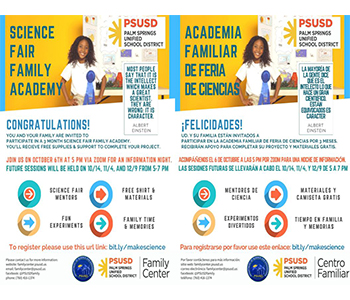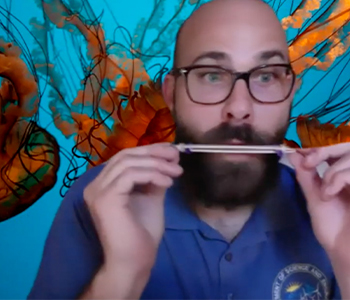Science Fair Family Academy
By Ruby Rivera, Palm Springs Unified School District (PSUSD) Family Engagement Coordinator and
Philip Hudec, PSUSD Secondary Science TOSA
Getting middle school students to participate in the annual science fair has always been challenging. And the fact that it’s a virtual science fair meant that we knew we had to do something new to support our students. Our plan: a Science Fair Family Academy for middle school students and their families. With the help of a grant from The PSUSD Foundation, we enlisted staff at the Palm Springs Unified School District Family Engagement Center: science teacher Nichi Avina, Technology Director Eddie Rivera and Elementary Science TOSA, Debbie Gordon. Together we hatched a plan. Our goal: To inspire families to further develop their interest in STEM related fields. Through exposure to engaging science and engineering lessons, families will also gain the knowledge and interest to successfully submit science fair projects to the district science fair competition and exhibition.
Why did we choose middle school students?
Research tells us that middle school is one of the most important parts of K-12 education. The data suggests that success in middle school leads to greater success in students’ academic careers as a whole. Therefore, we wanted to focus on middle schools to help students develop a love for learning and a thirst to figure things out. All kids are natural scientists and engineers. We are curious beings that thrive on asking questions and trying to make sense of the world around us. During this time of uncertainty, we are providing an opportunity for students and their families to be curious together and make sense out of the natural phenomena we present to them through each workshop during the PSUSD Science and Engineering Fair Family Academy.

First we had to recruit students and their families.
We sent out flyers (link) and had teachers nominate students. Students were nominated based on their interest in science and their willingness to attend all the sessions along with their families. Science kits with all of the materials needed for each virtual science experiment session were provided so that multiple family members could participate. Families picked up kits from the PSUSD Family Center.
Then we planned the sessions.
The first workshop session was held on October 14th from 5-7 pm virtually using Zoom. The focus of the workshop was on The Science and Engineering of Sound and Hearing. Students and their families participated in two science investigations in which they built their own musical instruments to learn about the physics of sound and explored an engineering solution related to using the physics of sound to help people hear. The most exciting part of the workshop was helping the students realize that they could “hear” without the use of their outer ear. The engineering solution they explored utilized the concept of bone conduction and the hearing device is called Bone Anchored Hearing Aid (BAHA).

On November 4 we focused on the importance of data collection and the crosscutting concept of scale by investigating terrestrial isopods. We began helping the students design their own projects focusing on a testable question they wanted to investigate or a problem they would like to solve. The December workshop focused on the science and engineering process as we assisted the students with their experimental design and analysis.
We also had great support from our district administration and PSUSD Board members who joined in on Zoom meetings and interacted with the students and families. This was fun and showed the importance of science for our students.
Plans for next year.
This year we started with 31 students from middle schools in Desert Hot Springs with 17 students completing all sessions. The Science Fair Family Academy will be expanding next year to include students and their families from all the middle schools in PSUSD. We love seeing families from different school sites connecting and collaborating.







